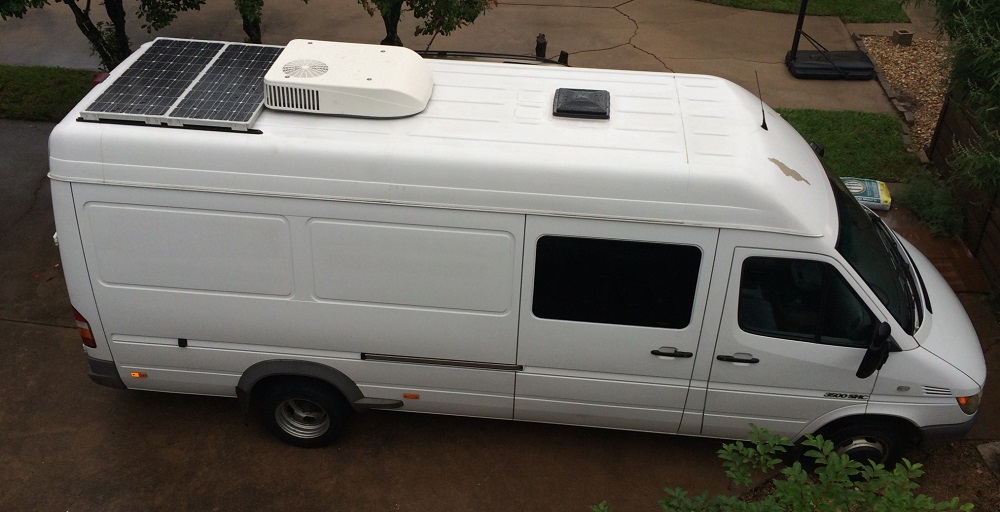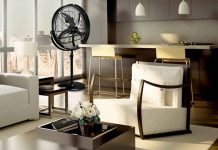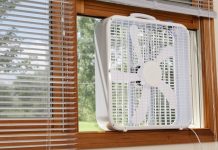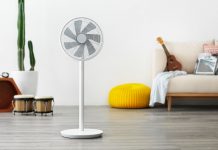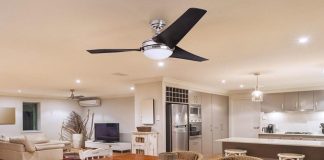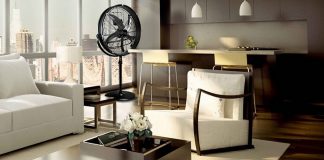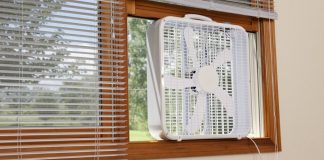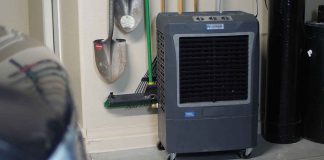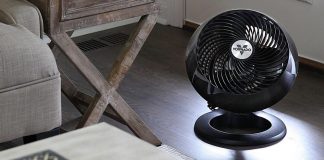One of the best additions a person can add to their RV is an air conditioner. It’s an appliance that will keep the interior cool and comfortable—which is vital during the hot months of summer. Unfortunately, some RV owners put off buying air conditioners for their rig because they either feel they’re too expensive or because they don’t know what to look for. To solve both of those problems, we decided to find the best RV air conditioners for our readers, as well as give them a guide that will help make the selection process easier. Sound good? Well, if it does, then let’s get started.
Quick Summary of the Best RV Air Conditioners
- Editor’s Choice: Airxcel Mach 15 Artic RV Air Conditioner (Amazon) – Review
- Also Recommended: Dometic Penguin II Polar White Air Conditioner (Amazon) – Review
- Also Consider: Dometic Polar White 13,500 BTU AC Unit (Amazon) – Review
Editor’s Choice: Airxcel Mach 15 Artic RV Air Conditioner
The Mach 15 is an RV air conditioner that not only has a classic look to it but it’s also a unit that has quite a bit of power. This product has 15,000 BTUs of cooling power and is equipped with a fan that’s moves air at 320 cubic-feet-per-minute. This allows this unit to cool down most recreational vehicles quickly, even during the blazing hot months of summer.
And it’s capable of doing it while pulling only 15-Amps and having a running watts standard of only 1,560-Watts. Even though it doesn’t have a thermostat, it’s capable of using control panels and thermostats in most RVs, so it’s quite easy to use.
This product is also easy to install, as long as the consumer reads and follows the manufacturer’s explicit instructions. Doing that, the consumer should have this unit up and running in no time flat. Another thing that we liked about this unit was that it also had a 5,600 BTU heater that’s more than enough to take the chill out of the air on a cold winter morning.
And its 1/3-HP fan motor is large enough to get some nice air circulation running through the recreational vehicle. That makes this a great product for ducted systems and one of the most powerful RV AC units available.
Thanks to its streamlined shape, this model can have an incredible amount of cooling efficiency and airflow. This product uses all-copper tubing and gas-flux brazes joints as well which ensures that the product is long-lasting. And it’s also equipped with large evaporator and condenser coils that have Lance fins that help the unit dissipate heat better than other types of air conditioners.
These features and these units exceptionally build quality makes it one of the best RV AC units currently available and the one that most people are going to want to install in their recreational vehicle.
Also Recommended: Dometic Penguin II Polar White Air Conditioner
The first thing that anyone will notice about this RV air conditioner is that it has a sleek design. And when we say sleek, we also mean slick. It’s a low profile design that just looks better than a lot of the bulky looking air conditioners currently available. But its low profile is not just a pretty face, it helps with the recreational vehicle’s performance.
Since its streamlined, drag is significantly reduced when the RV is moving, so the consumer doesn’t have to worry about their refueling bill suddenly going up when they install this unit on the roof of their recreational vehicle.
Another thing worth mentioning about this unit is that it’s lightweight as well, and is easy to install. Once installed, the consumer will enjoy a unit that can be used with both ducted and unducted systems with ease. This product uses R410 refrigerant that’s more efficient at releasing heat than some of the other refrigerants used in other air conditioner systems. With more heat released, the unit can cool down the inside of the RV quicker and more efficiently. And since this air conditioner has fully automated controls, it’s extremely easy to run.
Even though this unit comes with a Multi-Zone CCC II control board, what it doesn’t come with is a wall thermostat–which the consumer has to supply on their own. That’s not a problem since most units don’t come with thermostats, but it does mean that added costs are added to this product.
And this product is already expensive than any of the other ones we’ve reviewed. With that being said, however, we do have to say that this 15,000 BTU unit does do a good job of cooling down an RV and most consumers are going to be pleased using it.
Also Consider: Dometic Polar White 13,500 BTU AC Unit
There are quite a few reasons why this RV air conditioner does such a good job at lowering interior RV temperatures, even during hot summers. This model features large air openings that help to promote proper airflow, it has EPP foam housing that helps to reduce the weight of the unit, and it provides 13,500 BTUs of cooling power. It’s also a system that’s made with a carbon steel base that makes it more durable and a multispeed blower that blasts out the cold air. Although this unit is made with dampening units that are supposed to reduce the vibration and the noise of the unit, we did find that it was louder than some of the other RV air conditioners we’ve reviewed.
One of the things that we appreciated about this unit, however, was that it was easy to install. Following the product’s directions, most consumers should have no problem getting this unit installed on the roof of their RV. We also appreciate that the company that manufactures this unit, Dometic, stands behind their product with 2-year protection plus warranty.
That means that the consumer can rest assured that when they purchase this product they not going to have to worry about poor construction quality or inferior components. It’s a low priced unit, but that doesn’t mean that it’s cheaply made.
After carefully reviewing this product, we can safely say that it’s a great air conditioner for a recreational vehicle. It’s also one of the lowest price AC units that we’ve reviewed, which is great for people looking to install an RV air conditioner on a budget. It’s not the most powerful unit available, but it’s sure to get the job for most people. We think it’s a product that should last the consumer for quite a while and give them the cool air that they need and deserve.
The Ultimate Guide To RV Air Conditioners
Having just reviewed the last of the best RV air conditioners, and after having a few cups of coffee, we thought that it would be appropriate to give the consumer some information that will help them make an informed choice when buying a new AC unit for their recreational vehicle. In this helpful guide, we hope that all of our readers will find the information they need to make an informed buying decision. This guide will also give the consumer information on keeping their RV in good condition as well. So, let’s get started and spend a few moments talking about RV AC units.
How To Purchase A New RV Air Conditioner
The first part of this guide is dedicated to purchasing a new RV air conditioner. Although these AC units aren’t very complicated, there are a few features the consumer is going to want to think about before spending their hard-earned money. Let’s examine some of these features.
The AC Unit’s Power
The absolute number one thing that the consumer should consider is the power of the AC unit. These air conditioners are rated by BTUs and the higher the BTUs listed on the unit the more power it’s capable of delivering. Now that we’ve said that, it should also be noted that most RV air conditioners are in the 13,500 BTU to 15,000 BTU range. For most consumers, the 13,500 BTU models are generally powerful enough to cool down the RVs they’re listed on, but if the consumer is a desert dweller or living in an extremely hot climate, then they’re going to want to get an air conditioner with the highest BTU output available.
Is A Dual-Usage Unit Needed?
The next thing that the consumer is going to want to think about when choosing a new RV air conditioner is whether they need a dual-usage unit. Dual-usage units are the ones that not only can be used as an air conditioner but can also be used as a heater. Yes, dual-usage systems are also equipped with heat pumps which help to supplement the recreational vehicle’s heating system. We say supplement because these dual-usage systems don’t warm up the vehicle in extremely cold weather. They’re primarily used to take the edge off the air in temperatures above 45-degrees. Fortunately, the air conditioner part of these systems still usually works exceptionally well.
Consider The AC Unit’s Size
The next thing that the consumer is going to want to give a few moments of thought is the size of the unit. First of all, they want to make sure that they get a unit that will fit on their RV without them having to make a lot of alterations to the top of their RV. The consumer also might want to consider a model that has a lower profile. That will reduce the drag on the RV and will improve gas mileage. However, it should also be noted that lower profile AC units often have less power, so they’re not used as often on vehicles in warmer climates. For large rigs, or for rigs that operate in high-temperature conditions, the consumer is probably going to want to use a high-profile air conditioner and just deal with the additional drag.
Properly Maintaining Your RV Air Conditioner
Let’s say that you’ve purchased one of the RV air conditioners we’ve recommended and now you want to keep that unit running as long as possible. How can that be done? Well, that’s exactly what we’re going to address in this section of this guide. Below you’ll find some of the tips for keeping your RV air conditioner in good condition for as long as possible.
Read The Instructions
The first step to keeping the air conditioner in good condition is to read the unit’s instructions. All major RV AC units come with directions that tell the consumer how the unit should be installed and maintained. Following those directions are the first step towards keeping the air conditioner in good condition for years to come.
Change The Filter
The next step to keeping the unit in good condition is to regularly change the air filter. This is usually done by removing the air assembly, and then pulling out the old filter. Some air conditioners have reusable filters that just need to be cleaned, and other units have filters that have to be completely replaced with a new one. Make sure to do this at least every 30-days while the air conditioner is being used, or at the beginning and end of each season when the unit isn’t in use.
Check The AC Coils & Clean The Exterior
The filters should be checked every single time the air filter is being replaced. This can be done by inspecting the area with a flashlight. If the user sees any dust or dirt, they should use a stiff brush and a vacuum to clean it up. Once the filter has been replaced and the entire unit buttoned up, it’s also a good idea to clean the exterior of the unit.

